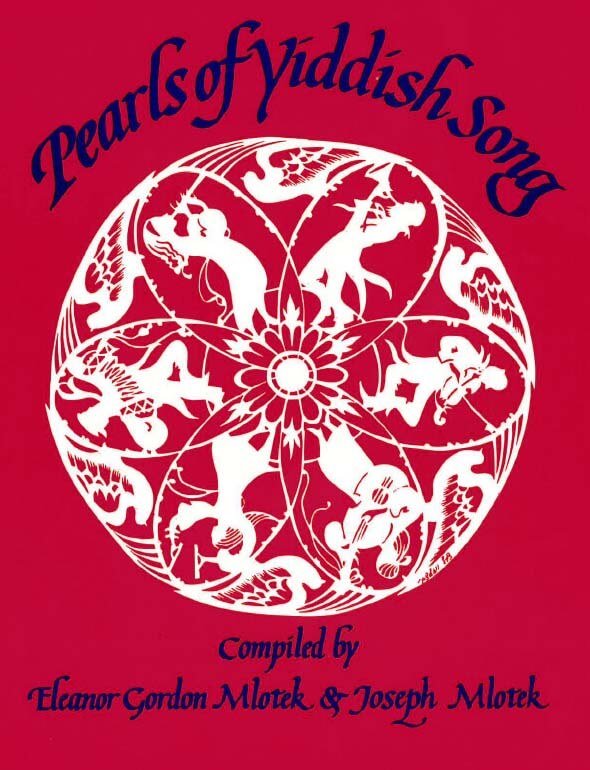Words by Jacob Adler (1873-1973), also known by his pen name B. Kovner. Originally entitled “Di bobe dertseylt” (Grandmother tells a story), the poem appeared in Adler’s book Lider (New York, 1924). The song was sung by Yosl Mlotek in Warsaw in the 1930’s.
The text has always been published anonymously: in 1927 In 100 naye folkslider; in 1966 with a different melody by Lin Jaldati and Eberhard Rebling; and in 1984 with the same melody by Bina Steinberg.
Identifying the source of this song was the original impetus in 1970 for initiating our weekly, later bi-weekly, column, “Pearts of Yiddish Poetry,” In the Jewish Forward.

My mother told me that, once upon a time,
there stood a little house, deep in a valley.
Next to the house there was a garden in bloom,
and inside the house there lived an upright Jew.
The Jew had an only daughter,
a virtuous daughter, talented and lovely,
with silky, curly black hair
and a pair of dark, enchanting eyes.
Nearby the house, at the very bottom of the valley
there rested a little pond like a steel mirror;
The girl bent herself over the pond
and looked into the steely water.
Looked into the water and longed for something,
and her face was sick with longing;
And she saw how from the deep lap of the water
a girl like her looked out from there.
A girl like her – and she heard a cry:
“I am an orphan, I am alone here,
Oh, come, pretty girl, and be with me,
and I shall be a friend to thee.”
The sun sent a smile down to the pond,
and blessed it with thousands of golden coins.
The girl from the valley was drawn to the shine
and went into the treasure of coins.
In the morning, the sky was despondent,
a breeze recited the Kaddish by the pond.
The breeze first – and her father last.
Soon her father sat Shive.
Note: Taykh is generally ‘river’, but it can also be ‘pond’, particularly in older Yiddish. ‘Taykhl‘, is even more often used for pond. A stream makes a poor mirror.
Es hot mir mayn mame dertseylt, az a mol
Geshtanen a shtibl iz tif in a tol,
A gortn baym shtibl geven iz tsebilt,
Gevoynt hot in shtibl an erlekher yid.
Baym yid iz an eyntsike tokhter geven,
A koshere tokhter, gerotn un sheyn,
Mit shvartse, gekrayzlte, zaydene hor,
Mit shvartse, farkishefte oygn a por.
Nisht vayt fun dem shtibl, gor untn in tol,
Gerut hot a taykh vi a shpigl fun shtol;
Dos meydl, es hot tsu dem taykh zikh gebukt
Un hot in dem shtolenem vaser gekukt
Gekukt in dem vaser, nokh epes gebenkt,
Geven iz ir ponim fun benkshaft gekrenkt;
Un zi hot gezen, az fun taykhs tifn shoys
A meydl, vi zi, kukt fun dortn aroys.
A meydl vi zi — un zi hert a geveyn:
— Ikh bin a yesoyme, ikh bin do aleyn,
O, kum, sheyne meydl, un zay nebn mir,
Un zayn vel ikh, meydl, a khaverte dir.
Di zun hot dem taykhl a shmeykhl geshikt,
Mit toyznter goldene rendlekh baglikt,
Dos meydl fun tol hot getsoygn tsum shayn
Un iz in dem oytser fun rendlekh arayn —
Oyf morgn geven iz der himl fartsogt,
Dos vintl baym taykhl hot kadlsh gezogt.
Dos vintl tsum ershtn — ir tate tsu letst,
Es hot zikh der tate bald shive gezetst.
עס האָט מיר מײַן מאַמע דערצײלט, אַז אַ מאָל
געשטאַנען אַ שטיבל איז טיף אין אַ טאָל,
אַ גאָרטן בײַם שטיבל געװען איז צעבליט,
געװױנט האָט אין שטיבל אַן ערלעכער ייִד.
בײַם ייִד איז אַן אײנציקע טאָכטער געװען,
אַ כּשרע טאָכטער, געראָטן און שײן,
מיט שװאַרצע געקרײַזלטע זײַדענע האָר,
מיט שװאַרצע, פֿאַרכּישופֿטע אױגן אַ פּאָר.
נישט װײַט פֿון דעם שטיבל, נאָר אונטן אין טאָל,
גערוט האָט אַ טײַך װי אַ שפּיגל פֿון שטאָל;
דאָס מײדל, עס האָט צו דעם טײַך זיך געבוקט
און האָט אין דעם שטאָלענעם װאַסער געקוקט.
געקוקט אין דעם װאַסער, נאָך עפּעס געבענקט,
געװען איז איר פּנים פֿון בענקשאַפֿט געקרענקט;
און זי האָט געזען, אַז פֿון טײַכס טיפֿן שױס
אַ מײדל, װי זי, קוקט פֿון דאָרטן אַרױס.
אַ מײדל װי זי — און זי הערט אַ געװײן:
— איך בין אַ יתומה, איך בין דאָ אַלײן,
אָ, קום, שײנע מײדל, און זײַ נעבן מיר,
און זײַן װעל איך, מײדל, אַ חבֿרטע דיר.
די זון האָט דעם טײַכל אַ שמײכל געשיקט,
מיט טױזנטער גאָלדענע רענדלעך באַגליקט,
דאָס מײדל פֿון טאָל האָט געצױגן צום שײַן
און איז אין דעם אוצר פֿון רענדלעך אַרײַן —
אױף מאָרגן געװען איז דער הימל פֿאַרצאָגט,
דאָס װינטל בײַם טײַכל האָט קדיש געזאָגט.
דאָס װינטל צום ערשטן — איר טאַטע צו לעצט,
עס האָט זיך דער טאַטע באַלד שבֿעה געזעצט.
Song Title: Di Mame Dertseylt

First published in 1988 as Pearls of Yiddish Song: Favorite Folk, Art and Theatre Songs, this anthology contains 115 songs. Some material had never been published, while others, included in rare song collections or sheet music, were largely inaccessible. The songs presented reflect Jewish life in Eastern Europe and the United States and depict childhood, love, family celebrations, poverty, work and struggle. There are also songs from the Hasidic and Maskilic movements, songs of Zion and of America, as well as songs from the Yiddish theater.
The title of this anthology derives from the weekly two-page feature column “Pearls of Yiddish Poetry,” which the compilers Yosl and Chana Mlotek initiated in 1970 in the Yiddish newspaper Der Forvertz (the Yiddish Daily Forward). Hundreds of readers from around the world — including authors, composers, singers, actors — became co-participants in this collective folk project and recalled melodies, lines, fragments, stanzas and their variants of songs, poems, and plays which they had heard in their youth. At first, readers sent in only written material. Later, they also taped songs on cassettes, many of whose melodies had, until then, never been recorded. They also identified and supplied missing information regarding lyricists, poets, and composers and described the circumstances surrounding the songs’ origins, their dissemination, diffusion and impact.